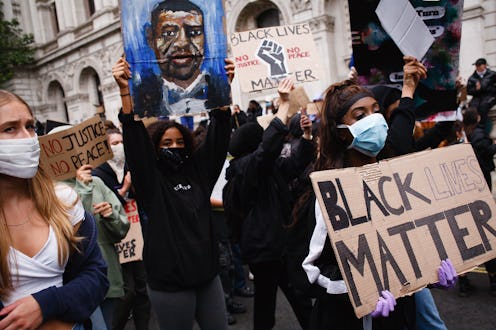(Culture)
What Not To Wear To A Protest

Protests are the bedrock of progress. For generations on end, peaceful assembly has routinely been a catalyst for change, from the Civil War to the Civil Rights Movement. As the omnipresence of institutionalized racism continues, it's easy to want to jump right in and exercise your right to assemble — but preparedness is vital for keeping yourself safe, no matter what transpires while marching. Before you go, we're taking a look at what not to wear to a protest, including suggestions on best alternates for your more-essential pieces.
Since George Floyd's death on May 25, colossal protests have taken effect in LA, Paris, NYC, Brazil and beyond — all geared to bring justice to the needless deaths in the Black community at the hands of police brutality. The marches and the Black Lives Matter movement have pressed government officials to enact change — some of which has already begun to take shape. Since the protests began, all four officers who killed Floyd were charged; chokeholds have been banned in many states; and many governors are developing reform packages that will increase transparency into officer's disciplinary records. As a response to the growing momentum behind defunding the police, NYC Mayor Bill De Blasio has announced plans to reallocate NYPD funding for social services and youth services, which will materialize in a matter of weeks.
All of these are veritable victories. Still, there's far more change to fight for — and the protests are not slowing down. And while most of those protesting can look forward to a peaceful, empowering demonstration, stories of police departments using excessive force, tear gas, and other tactics to keep crowds in control are more and more common.
Before you go, ensure your safety by browsing the key pieces that may do more harm than good:
1. Contact Lenses
Contact lenses can trap tear gas and other chemicals under the lens, making exposure to anything of the sort while protesting exponentially more painful. Many pairs of safety goggles are designed to be worn comfortably over eyeglasses, and they can provide protection against rubber bullets.
2. Clothing With Logos
The goal is to not draw attention to yourself with anything remarkable, or anything that you may be able to be recognized and identified for. Logos fall into that category — and, with the current heat brands are getting for accusations of racism in the workplace, going logo-less may be your best bet for the time being if you have yet to investigate your favorite brands' ethics.
3. Bold Colors/Patterns
The same goes for vibrant clothing. To maintain a low profile, opt for solids and darker shades to blend in with groups and avoid being singled out. You can save all your punchier hues and prints for brighter days ahead.
4. Cotton/Wool Garments
To get ahead of unpredictable weather, be sure to avoid materials that fair poorly with moisture, including cotton and wool. Polyester and nylon are safer materials — and many brands custom-design their own sweat-wicking fabrics, such as TWENTY Montreal's 3D Knit texture.
4. Thin Clothing
Layering up has been accepted as the best defense to chemical exposure. If you do come in contact with something, you can always remove the outer layer — so make sure that all skin is covered and protected. Wearing a tightly-drawn hood can help protect the face as well.
5. Makeup
Oil-based products (sunscreens, serums, and cosmetics) can trap pepper spray and other chemicals in the skin, thus risking greater irritation over a longer period of time. Go clean-faced as a precaution, and your skin will thank you.
6. Luxury Items
While also drawing unwanted attention, jewelry has the unintended ability to induce harm on your body. Earrings and necklaces can be tugged, rings can cause scrapes, and so forth. While protesting, your talismans are best kept home, safe and sound.
This article was originally published on